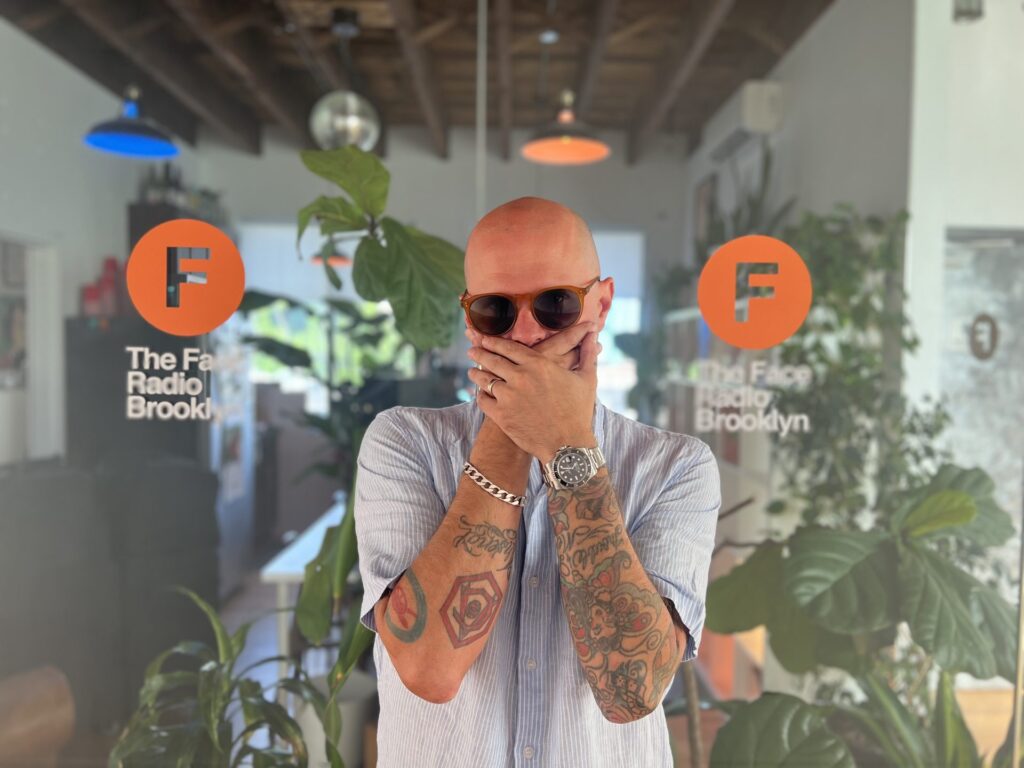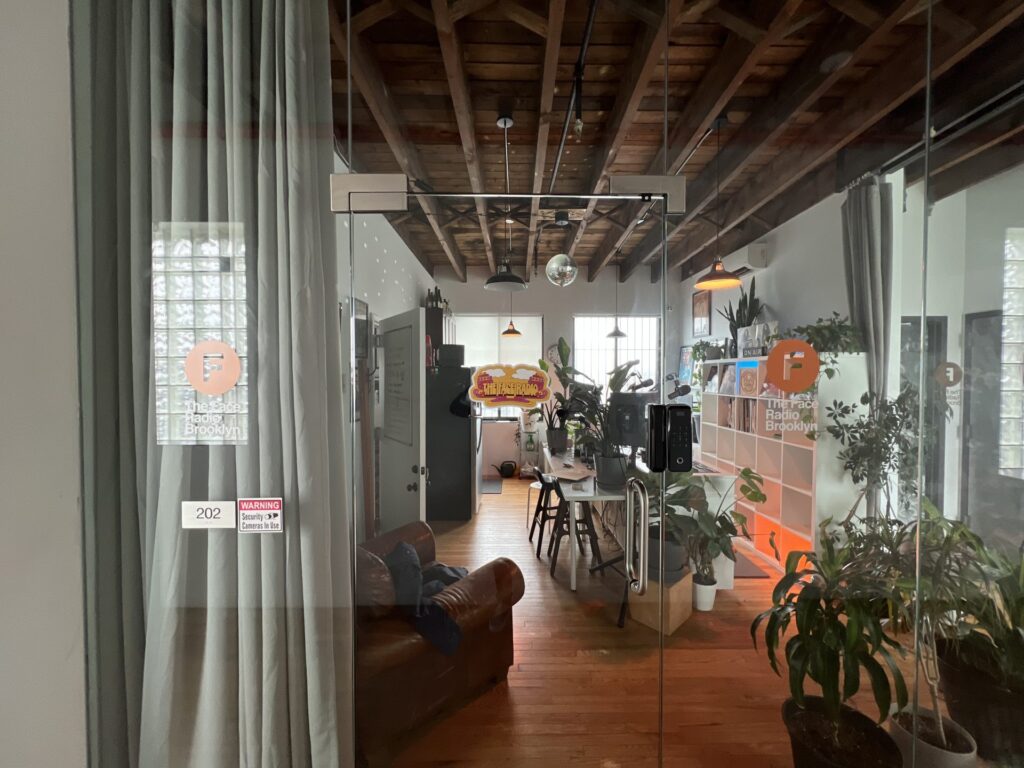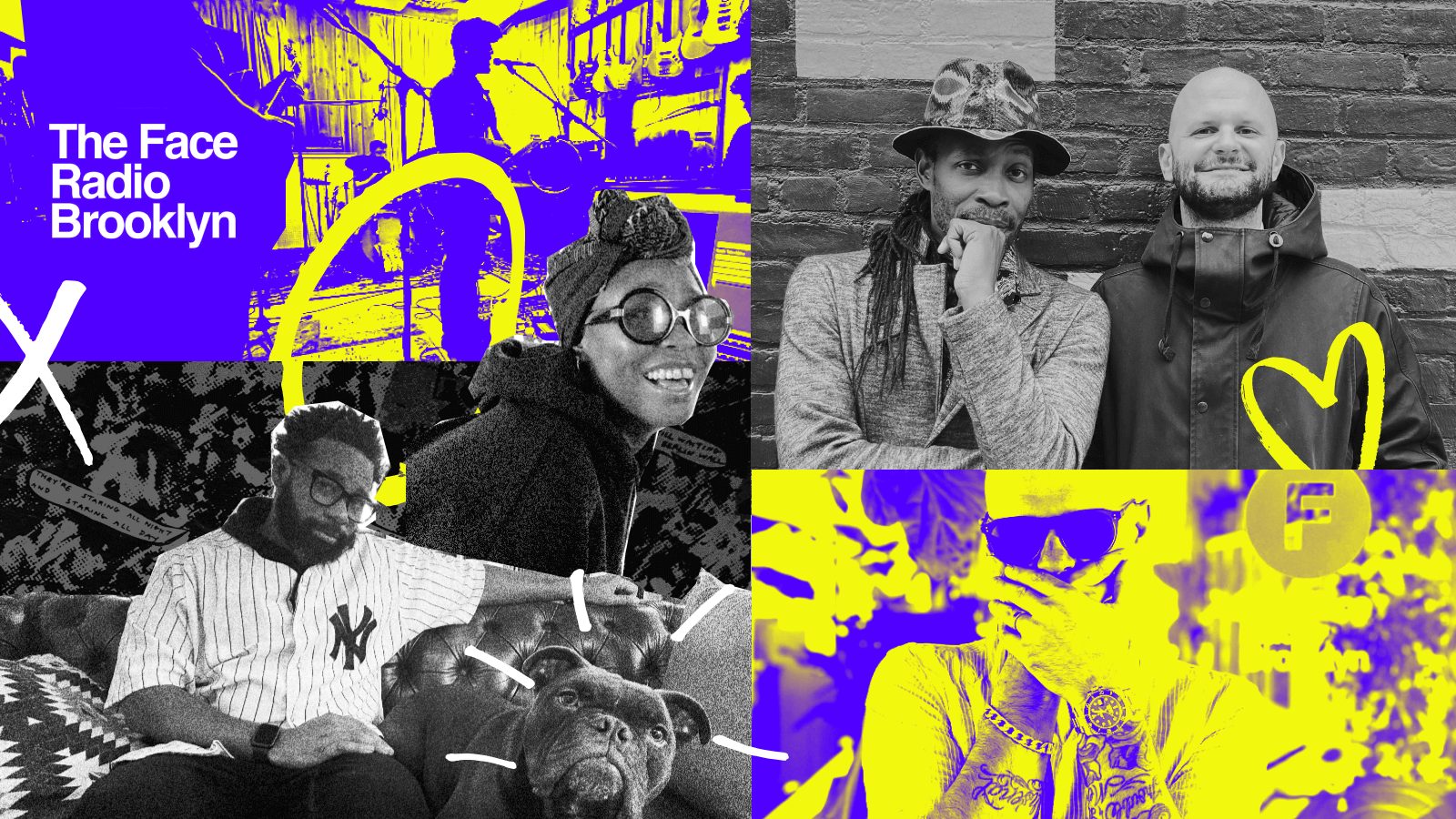You never know just how far your radio station will reach when you start one. But it can often leave you surprised at the possibilities once you find your audience. Broadcasting out of Brooklyn, New York, The Face Radio carves lines around the world.
Despite originating in the USA, the station has hosts from everywhere from the UK to Australia, with daily programming and shows that explore sounds of all kinds. The fact that hosts are based all around has allowed the station to build deep roots and organically find friends in new places. To find out more, we spoke to The Face’s founder, Kurtis Powers, who shares the history of the station, its iconic branding and the importance of connecting communities around the world.

How did The Face Radio come about?
Kurtis: Years back, I had begun doing my own radio program that was called The Face on a station here in Brooklyn. It was co-broadcasting on two stations in the UK. The night before I was meant to have the first ever radio interview with Duran Jones and the Indications, I was testing the system and I noticed that my password had been changed. Then I found out I had actually been removed from the radio station.
I’m kind of a problem solver and I knew all of the broadcast software that I needed to do to set up a show. I’m a creative director and UX designer and my wife is a web developer. So with about six hours to go we put up a landing page, signed up for a broadcast server and put a player on the page. I just hit socials really hard to say, ‘change of plans you can listen to me here tomorrow.’ That was essentially the start of what is now The Face Radio.
Fast forwarding a few years, I started reaching out to mates that were doing programs as well. I think some of the first shows on the station were our friends Disco Freaks who are London-based and broadcast on Hoxton Radio. We had a guy called Pete Mitchell who sadly is no longer with us who is a pretty legendary UK broadcaster. Radio created this easy connection. By 2019, I would say I got the courage to announce what we’ve been doing all this time. I had people that would come into my home on their own to broadcast their shows. We got a proper space in November 2019. But there were quite a few months where there was no one in the studio because of this funny little thing that happened in the world! We got back in pretty much as soon as we could.
I was able to onboard DJs so that they could broadcast from their home studios. Once we came out of COVID some of the DJs just kept doing that. A lot of people would also still come into the studio. At this point, everyone whose live is broadcasting from home studios but we also stream both on the station and on Mixcloud Live. We’ve got about 94 DJs worldwide and we’re still broadcasting essentially 24/7.
What influenced the creative direction of your branding?
I am very much a modernist at heart when it comes to design. The F in our main logo is taken from the New York City subway. Just down the street from here, there’s an F train and that’s the line that I was closest to when I made it. I thought of travel. Things like air and train travel and modes that we use to connect people to different areas.
It’s iconic because one of the most legendary designers ever in my opinion is an Italian guy called Massimo Vignelli. Our show artwork design is actually a play on his 1972 design of the New York City subway poster. The different colors represent different train lines. It was just a way to showcase the diversity of what we think we are and want to be. It’s a diverse crossover of places coming together.
How have you crafted the station’s programming?
We’re always looking at how it benefits the community. Is there another personality that will add something to the station? I look at it as very much community focused. We want to make connections with people that bring a light to the world.
I think there’s not an equal equity in radio at all in terms of overall people of color, women, LGBTQ people. There’s a lot of white men doing radio, including myself. We think of New York and the other cities we represent, London, Brighton, and want to represent the diversity of these cities we live in. The different worlds we inhabit. I think that’s such a beautiful thing that we can celebrate but also find that fluidity between what brings us together at the end of the day, which is just good music, good attitudes and good spirits.
How has The Face Radio created a lane for itself in independent radio?
We are incredibly mission driven. We’re not just want people on the radio to play music, anyone can do that. We want our presenters to be interesting, eclectic but not pretentious. People that like to share. For me, sharing and connecting is the most important reason we do this. COVID had a silver lining for us because we were able to engage so many more people during that time. The thinking being, ‘we can’t go into the studio anymore, how are we going to keep people connected?’ We’re glad to tell you what we’re playing. It’s not like you’re this cool person playing the song you’ve never heard before and you’re not going to tell people what it is and they can’t Shazam it.
I think our presenters are diverse and broad in sound and we’re constantly looking for different, non-mainstream sounds. We want to keep it interesting. There’s a million stations that are just going to play the hits and that’s cool, but that’s not really us.
Talk to us about your studio setup. What does it look like?
Big thanks to the guys over at Mastersounds, we have one of their 4V rotary mixers and Clarity A speakers. A set of Pioneer DJM 900 Nexus 2’s. Some Technics turntables and an inexpensive compressor that we like to call the RCN – the Really Nice Compressor! We have a Yamaha 18-channel mixer which is our main broadcast mixer. We tend to use the Scarlett 2i2 USB audio interface. The music tends to travel to the Yamaha into the RCN and then into the Scarlett, running into a Mac Mini.
For our broadcasts we use Audio Hijack which has allowed us to maintain consistency with our sound. It enables us to broadcast on our broadcast server and then run a virtual audio output that runs into OBS, which powers our Mixcloud Live streams. People listening on Mixcloud Live can enjoy the same audio quality as our broadcast streams. That’s super important to us.
How has having a presence on Mixcloud impacted the station’s journey?
Mixcloud has always been about the music and the DJs who bring it forward. It has always felt nurturing of the creators and the music. I’ve personally been uploading for over a decade and I’ve seen how far the platform has come. Mixcloud Live has helped us reach so many new voices and places. We’re truly happy to be part of what we consider the world’s music community, and I don’t say that lightly.
Do you use Host Tagging? How has that enhanced your Mixcloud experience?
I love it. Going back to our mission statement of connecting people, it’s really a boost for that. We have this new rule and we’re still kind of drilling it into some of our presenters that they need to click that link that makes them a host. In our new onboarding process, it’s a requirement now that in order to join the station, you have to link your Mixcloud profile as a host on our station. We really believe in [Host Tagging], so much so that we’ve made it a requirement! We look at Mixcloud as almost a more important tool than Instagram or any other social platform.
You place a lot of importance on reaching new communities through The Face Radio. Tell us about how you’ve been able to do this.
It becomes easier because our presenters are around the world. I almost look at the station as an invisible umbrella that is the home of all these communities that all make up the greater community. I remember we brought on a guy from Glasgow and then within two months I think we had three other DJs from Glasgow because it just grew. We brought in a woman called Kelly-Anne Byrne who was on national FM radio in Ireland for a long time and the amount of Irish listenership that we got that now supports us is amazing. So I think if you build a community that doesn’t have things that are taking from it but contributing to it, it will naturally grow.
Outside of that, we do a quarterly party in London called ‘Out On The Floor.’ Some of the guys have gotten together and thrown parties in Berlin. The Bowery Presents, the entity that not only oversees almost all the music events here in New York City, but also in a number of different cities in the country, told us they love what we’re doing. We’re in talks to make it so that we can be a mouthpiece for them and they can support us, which is very exciting.
What have been some of your favorite moments from the history of The Face Radio?
The week Mixcloud Live was launched was about a week away from International Jazz Day 2020. We decided to, with a combination of Zoom and OBS, live stream DJ sets for 24 hours. I work in marketing so we framed it as ‘International Jazz Day: Internationally Live.’ We had Greg Jay out in Oakland, California as our MC and me in New York sat with OBS and Zoom going.
One person would do a broadcast and they might have been in Australia. Then I would transition with Zoom and Mixcloud to the next person that was waiting in the Zoom chat. We then transferred them over and then they would go on for their hour and we did that for 24 hours. By the 22nd hour, I was drinking tequila and so fried! But it was so fun to use Mixcloud as that platform. Our numbers during the COVID period were unbelievable but that day was literally through the roof. I remember even somebody from Mixcloud writing to me and telling me how great it was. It was absolutely massive for us.
What does the future hold for you guys?
It’s very unwritten. We get a lot of donations as a non-profit organization but there are a lot of financial overheads. When you play music, it costs money, so we’re looking at ways we can engage more people and encourage partnerships with other companies. Those that share our vision for bringing people together. As technology evolves, we want to be able to solve the problems we’re in right now that will then enable us to continue to grow. But we’re always going to try to grow our community. Our voice in other countries, and find ways to do fun things within them. We don’t have a financial goal – no one gets paid [laughs]! But being able to connect with like minded people is the most important thing, and we’ll continue to do that.


